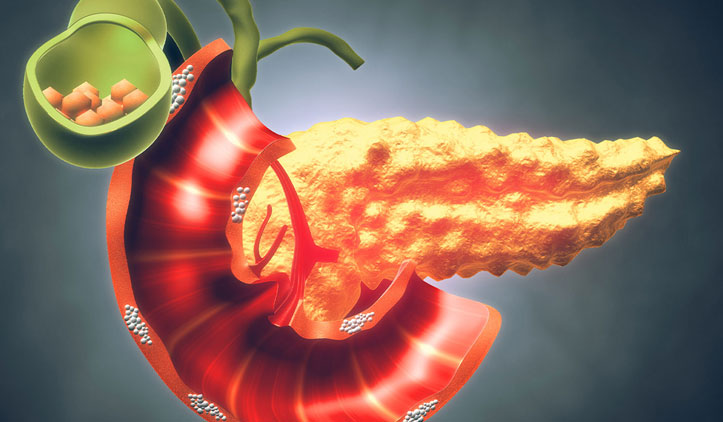Pancreatic Cancer

What Is Pancreas?
The pancreas is a spongy, tube-shaped organ about 15 cm long. It is located in the back of the abdomen, behind the stomach. The head of the pancreas is on the right side of the abdomen. It is connected to the duodenum, the upper end of the small intestine. The narrow end of the pancreas, called the tail, extends to the left side of the body.
What are symptoms of Cancer of the Pancreas?
Pancreatic cancer has been called a "silent" disease because early pancreatic cancer usually does not cause symptoms. If the tumor blocks the common bile duct and bile cannot pass into the digestive system, the skin and whites of the eyes may become yellow, and the urine may become darker. This condition is called jaundice.
As the cancer grows and spreads, pain often develops in the upper abdomen and sometimes spreads to the back. The pain may become worse after the person eats or lies down. Cancer of the pancreas can also cause nausea, loss of appetite, weight loss, and weakness.
How is cancer of the Pancreas diagnosed?
To diagnose pancreatic cancer, the doctor does a complete physical exam and asks about the patient's personal and family medical history. Other tests may be ordered, such as CT scans, x-rays that give detailed pictures of a cross- section of the pancreas. A biopsy is the only sure way for the doctor to know whether cancer is present. In a biopsy, the doctor removes some tissue from the pancreas. It is examined under a microscope by a pathologist, who checks for cancer cells.
Treatment Option
Cancer of the pancreas is curable only when it is found in its earliest stages, before it has spread. Otherwise, it is very difficult to cure. However, it can be treated, symptoms can be relieved, and the quality of the patient's life can be improved. Pancreatic cancer is treated with surgery, radiation therapy, or chemotherapy.
Surgery
Surgery may be done to remove all or part of the pancreas. Sometimes it is also necessary to remove a portion of the stomach, the duodenum, and other nearby tissues
Radiation
Radiation therapy (also called radiotherapy) uses high-powered rays to damage cancer cells and stop them from growing. Radiation is also used as a way to kill cancer cells that remain in the area after surgery.
Chemotherapy
Chemotherapy uses drugs to kill cancer cells. The doctor may use just one drug or a combination. Chemotherapy may be given by mouth or by injection into a muscle or vein. The drugs enter the bloodstream and travel through the body.
Request For An Appointment
Tay Khoon Hean Surgery is located in the Gleneagles Medical Centre. The clinic and its friendly, caring and dedicated staff offer a comprehensive service in all aspects of General Surgery. The clinic provides a comfortable and warm waiting area with a fully equipped treatment facility for minor surgical procedures.

Clinic Address
Gleneagles Medical Centre6 Napier Road, #08-02Singapore 258499
Contact Information
Tel : +65 6471 1221
Email : tkhsurgery@yahoo.com.sg
24hr Emergency Hotline : +65 6535 8833
Consultation Hours
Mon - Fri : 8:30am - 5:00pm
Sat : 8:30am - 1:00pm
Sun & PH : Closed

